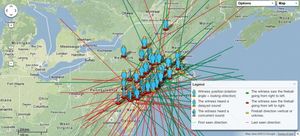The American Meteor Society has received 50 reports of a bright meteor that occurred near 06:33 EST on Saturday evening January 5, 2013. Brightness estimates of this fireball vary considerably, but the average lies near magnitude -18, which lies between the light produced by the full moon and the sun. Every color of the rainbow has been reported with green being most mentioned. Below is a map of the witness reports for the NE USA fireball event and can also be found in the fireball logs, refer to event 28 for 2013. Click the image below to see the interactive event map.
For those not familiar with meteors and fireballs, a fireball is a meteor that is larger than normal. Most meteors are only the size of small pebbles. A meteor the size of a softball can produce light equivalent to the full moon for a short instant. The reason for this is the extreme velocity at which these objects strike the atmosphere. Even the slowest meteors are still traveling at 10 miles per SECOND, which is much faster than a speeding bullet. Fireballs occur every day over all parts of the Earth. It is rare though for an individual to see more than one or two per lifetime as they also occur during the day, on a cloudy night, or over a remote area where no one sees it. Observing during one of the major annual meteor showers can increase your chance of seeing another one of these bright meteors.
Meteors often appear much closer than they really are. I receive countless reports that the object landed just over the hill when in fact it was several hundred miles away and was witnessed over several states. It is your perspective that makes meteors appear to strike the horizon when in fact they are still high in the atmosphere. This is much like a jetliner seen low in your sky. It appears low to you but for someone located many miles away in that direction, the jetliner is passing high overhead. Meteors become visible at approximately 50 miles above the Earth's surface. Friction slows these objects down until they fall below the velocity necessary to produce light. At this point they still lie at least 5 miles high in the sky. They are invisible below this altitude and cannot be seen as they basically free falling to the ground at 200mph. Very few meteors actually reach the ground as 99.99% completely disintegrate while still 10-20 miles up in the atmosphere.
For those not familiar with meteors and fireballs, a fireball is a meteor that is larger than normal. Most meteors are only the size of small pebbles. A meteor the size of a softball can produce light equivalent to the full moon for a short instant. The reason for this is the extreme velocity at which these objects strike the atmosphere. Even the slowest meteors are still traveling at 10 miles per SECOND, which is much faster than a speeding bullet. Fireballs occur every day over all parts of the Earth. It is rare though for an individual to see more than one or two per lifetime as they also occur during the day, on a cloudy night, or over a remote area where no one sees it. Observing during one of the major annual meteor showers can increase your chance of seeing another one of these bright meteors.
Meteors often appear much closer than they really are. I receive countless reports that the object landed just over the hill when in fact it was several hundred miles away and was witnessed over several states. It is your perspective that makes meteors appear to strike the horizon when in fact they are still high in the atmosphere. This is much like a jetliner seen low in your sky. It appears low to you but for someone located many miles away in that direction, the jetliner is passing high overhead. Meteors become visible at approximately 50 miles above the Earth's surface. Friction slows these objects down until they fall below the velocity necessary to produce light. At this point they still lie at least 5 miles high in the sky. They are invisible below this altitude and cannot be seen as they basically free falling to the ground at 200mph. Very few meteors actually reach the ground as 99.99% completely disintegrate while still 10-20 miles up in the atmosphere.
Read more at - http://www.amsmeteors.org/fireball_event/2013/28#top
